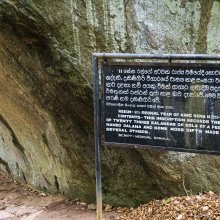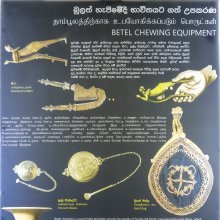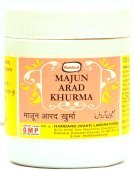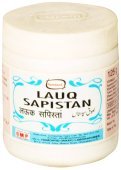Kalan, Kalaṉ, Kaḷaṉ, Kālaṉ, Kāḷaṉ, Kāḷāṉ: 4 definitions
Introduction:
Kalan means something in Hindi, biology, Tamil. If you want to know the exact meaning, history, etymology or English translation of this term then check out the descriptions on this page. Add your comment or reference to a book if you want to contribute to this summary article.
Ambiguity: Although Kalan has separate glossary definitions below, it also represents an alternative spelling of the word Kalana.
Images (photo gallery)
Biology (plants and animals)
Source: Google Books: CRC World Dictionary (Regional names)1) Kalan in India is the name of a plant defined with Mitragyna parvifolia in various botanical sources. This page contains potential references in Ayurveda, modern medicine, and other folk traditions or local practices It has the synonym Nauclea parvifolia Willd., nom. illeg. (among others).
2) Kalan in Nepal is also identified with Hypericum oblongifolium It has the synonym Hypericum oblongifolium Hook..
Example references for further research on medicinal uses or toxicity (see latin names for full list):
· Observ. Naucl. Indic. (1839)
· Species Plantarum (1798)
· Botanical Magazine, or ‘Flower-Garden Displayed’ (4949)
· Pl. Coromandel (1795)
· Prodr. Monogr. Hyper. (1821)
If you are looking for specific details regarding Kalan, for example pregnancy safety, chemical composition, extract dosage, diet and recipes, health benefits, side effects, have a look at these references.

This sections includes definitions from the five kingdoms of living things: Animals, Plants, Fungi, Protists and Monera. It will include both the official binomial nomenclature (scientific names usually in Latin) as well as regional spellings and variants.
Languages of India and abroad
Hindi dictionary
Source: DDSA: A practical Hindi-English dictionaryKalan in Hindi refers in English to:—(nm) calculus; calculation..—kalan (कलन) is alternatively transliterated as Kalana.
...
Kannada-English dictionary
Source: Alar: Kannada-English corpusKālān (ಕಾಲಾನ್):—
1) [verb] to get strength to walk.
2) [verb] (fig.) to get boldness (to face a danger).
Kannada is a Dravidian language (as opposed to the Indo-European language family) mainly spoken in the southwestern region of India.
Tamil dictionary
Source: DDSA: University of Madras: Tamil LexiconKalaṉ (கலன்) noun cf. kalaha. Encumbrance; வில்லங்கம். மனைக்கு . . . எப்பேர்ப்பட்ட கலனு மில்லை [villangam. manaikku . . . epperppatta kalanu millai] (S.I.I. i, 104).
--- OR ---
Kaḷaṉ (களன்) noun < களம்² [kalam²]
1. See களம்². [kalam².]
2. Agricultural tract; மருதநிலம். (திவா.) [maruthanilam. (thiva.)]
3. Natural reservoir of water; பொய்கை. (திவா.) [poykai. (thiva.)]
--- OR ---
Kaḷaṉ (களன்) noun probably from kala. Sound, noise; ஒலி. (திவா.) [oli. (thiva.)]
--- OR ---
Kaḷaṉ (களன்) noun < gala. Throat, neck; கழுத்து. (திவா.) [kazhuthu. (thiva.)]
--- OR ---
Kaḷaṉ (களன்) noun perhaps from கல-. [kala-.]
1. Attachment, connection; தொடர்பு. (திவா.) [thodarpu. (thiva.)]
2. Stupor, bewilderment; மயக்கம். (பிங்கலகண்டு) [mayakkam. (pingalagandu)]
--- OR ---
Kālaṉ (காலன்) noun < kāla.
1. Yama; யமன். காலனென்னுங் கண்ணிலி யுய்ப்ப [yaman. kalanennung kannili yuyppa] (புறநானூறு [purananuru] 240, 5).
2. Yama's messenger; யமகிங்கரன். [yamagingaran.] (சீவகசிந்தாமணி [sivagasindamani] 1487, உரை. [urai.])
3. Gift made with a view to propitiate Yama; காலதானம். காலன்கொண்டு [kalathanam. kalankondu] (ஈடு-முப்பத்தாறுயிரப்படி [idu-muppatharuyirappadi], 10, 3, 5).
4. Saturn; சனி. (சதுராகராதி) [sani. (sathuragarathi)]
5. One of the unseen heavenly bodies; கரந்துறைகோள்களுள் ஒன்று. [karanthuraigolkalul onru.] (W.)
6. A mineral poison. See காந்தபாஷாணம். (வைத்திய மூலிகை) [kanthapashanam. (vaithiya muligai)]
7. A prepared arsenic. See நீலபாஷாணம். [nilapashanam.] (W.)
--- OR ---
Kāḷaṉ (காளன்) noun < kāla. The commander-in-chief of Mahā Śāstā; மாசாத்தாவின் சேனாபதியாகிய மாகாளன். [masathavin senapathiyagiya magalan.] (கந்தபு. மகாசாத். [kanthapu. magasath.] 67.)
--- OR ---
Kāḷaṉ (காளன்) noun < Malayalam kāḷan. A savoury fluid treated with vegetables and spices; பச்சடி வகை. [pachadi vagai.] Local usage
--- OR ---
Kāḷāṉ (காளான்) noun Fungus, mushroom, toadstool, the harmless variety being Agaricus campestris; நாய்க்குடை. [naykkudai.]
--- OR ---
Kalaṉ (கலன்) noun (அகராதி நிகண்டு [agarathi nigandu])
1. Jewel; பூண். [pun.]
2. Boat; நாவாய். [navay.]
3. Lute; யாழ். [yazh.]
--- OR ---
Kalaṉ (கலன்) noun < khala. (நாநார்த்த. [nagarthathipigai])
1. Tale-bearer; கோட்சொல்லி. [kodsolli.]
2. Wicked person; துஷ்டன். [thushdan.]
Tamil is an ancient language of India from the Dravidian family spoken by roughly 250 million people mainly in southern India and Sri Lanka.
See also (Relevant definitions)
Starts with (+277): Kal-ankacu, Kal-ankorai, Kal-antalai, Kala-nataikanakku, Kalamci, Kalamdani, Kalamdhakara, Kalamdhara, Kalamdige, Kalamduge, Kalamgan, Kalamgey, Kalamgi, Kalamguli, Kalamji, Kalamjige, Kalamjisoppu, Kalamjiyagidu, Kalamju, Kalamkadhara.
Ends with (+59): Akalan, Akkalan, Arukalan, Atankalan, Avarkalan, Avkalan, Bangkalan, Bantakalan, Boi kalan, Cakalan, Cetakkalan, Cirukalan, Dagkalan, Dangkalan, Dingkalan, Ekapinkalan, Elaichi kalan, Erikalan, Heel kalan, Ikalan.
Full-text (+75): Kalancakkalatti, Kalancampa, Peru-kalancey, Vira-makalan, Cetakkalan, Kalanili, Elaichi kalan, Por-kalanirukkai, Ilaichi kalan kofta, Kalanirukkai, Kateli kalan, Peykkalan, Arukalan, Nir-peykalan, Terrukkalan, Manarkalan, Khusrave-durue-kalan, Ilaichi kalan nim kofta, Kappaikkalan, Avarkalan.
Relevant text
Search found 10 books and stories containing Kalan, Kalaṉ, Kaḷaṉ, Kālaṉ, Kāḷaṉ, Kāḷāṉ, Kālān, Kaalan, Kaalaan; (plurals include: Kalans, Kalaṉs, Kaḷaṉs, Kālaṉs, Kāḷaṉs, Kāḷāṉs, Kālāns, Kaalans, Kaalaans). You can also click to the full overview containing English textual excerpts. Below are direct links for the most relevant articles:
Tiruvaymoli (Thiruvaimozhi): English translation (by S. Satyamurthi Ayyangar)
Pasuram 4.6.4 < [Section 6 - Sixth Tiruvaymoli (Tirpparai yam ini)]
Pasuram 4.1.9 < [Section 1 - First Tiruvaymoli (Oru nayakamay)]
Pasuram 9.5.7 < [Section 5 - Fifth Tiruvaymoli (Innuyirc cevalum)]
Chaitanya Bhagavata (by Bhumipati Dāsa)
Verse 3.3.123 < [Chapter 3 - Mahāprabhu’s Deliverance of Sarvabhauma, Exhibition of His Six-armed Form, and Journey to Bengal]
Verse 3.3.127 < [Chapter 3 - Mahāprabhu’s Deliverance of Sarvabhauma, Exhibition of His Six-armed Form, and Journey to Bengal]
Vietnamese Buddhist Art (by Nguyen Ngoc Vinh)
5. Buddhist monuments in Champa < [Chapter 2 - Similarity of Buddhist monuments in South Vietnam and South East Asia]
1. Sculptures in Champa < [Chapter 4 - The Sculpture and its Reciprocal Influence]
Garga Samhita (English) (by Danavir Goswami)
Verse 6.6.31 < [Chapter 6 - The Yādavas’ Victory When Śrī Rukmiṇī is Kidnapped]
The Religion and Philosophy of Tevaram (Thevaram) (by M. A. Dorai Rangaswamy)
Chapter 3.6 - Kalasamhara-murti (Markandeya and the conquest of death) < [Volume 2 - Nampi Arurar and Mythology]
Nayanar 39: Kootruva (Kurruva) < [Volume 4.1.1 - A comparative study of the Shaivite saints the Thiruthondathogai]
Symbology of the skull in the Mahavrata < [Volume 2 - Nampi Arurar and Mythology]
Middle Chola Temples (by S. R. Balasubrahmanyam)
Individual Donors < [Tanjavur/Thanjavur (Rajarajesvaram temple)]
Temples in Narttamalai < [Chapter II - Temples of Rajaraja I’s Time]
Temples in Kuvam < [Chapter IV - Temples of Rajendra I’s Time]
Related products




